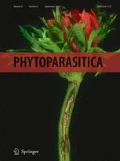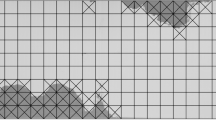Abstract
Whole wheat grain bait, treated with sodium fluoroacetate, is used to control field rodents in Israel. However, this bait constitutes a potential primary non-target hazard to seed-eating birds. In the present study black-, red-, green- and yellow-dyed whole wheat and sorghum grains, as well as undyed ones, were offered to feral pigeons,Columba livia, and to chukar partridges,Alectoris chukar, in the laboratory during 4 days. Grains were offered either piled on trays, or scattered. Consumption levels varied significantly (P<0.05) among varieties. The pigeons preferred undyed grain; black and yellow grains were consumed the least. The partridges preferred the undyed and black grains to all the other colored grains. When no undyed alternative was offered, the pigeons preferred red and green, and the partridges — black wheat. The pigeons preferred wheat whole grain, and the partridges — sorghum whole grain. When the pigeons received sorghum, a disliked grain, no significant difference (P>0.05) was observed in the consumption of the differently dyed grains.
Similar content being viewed by others
Reefrences
Anon. (1967) [Prevention of the damage of field rodents.] Israel Ministry of Agriculture, Plant Protection Department, Tel Aviv, Israel, (in Hebrew).
Benjamini, L. (1980) Feeding behavior of the chukar (Alectoris chukar) in sugar beet plantations.Phytoparasitica 8:3–18.
Bodenheimer, F.S. (1949) Problems of Vole Populations in the Middle East. Report on the Population Dynamics of the Levant Vole (Microtus guentheri D. et A.). The Research Council of Israel, Jerusalem, Israel.
Cochran, W.G. and Cox, G.M. (1975) Experimental Design. 2nd ed. Wiley, New York, NY.
Hegdal, P.L., Fagerstone, K.A., Gatz, T.A., Glahn, J.F. and Matchke, G.H. (1986) Hazards to wildlife associated with 1080 baiting for California ground squirrels.Wildl. Soc. Bull. 14:11–21.
Kalmbach, E.R. (1943) Birds, rodents and colored lethal baits.Trans, 8th North American Wildlife Conf. (Washington, DC), pp. 409–415.
Marsh, R.E. (1985) Techniques used in rodent control to safeguard nontarget wildlife.Trans. Western Section Wildlife Soc. Annu. Meet. (Monterey, CA, USA), pp. 47–55.
Mastrota, FN. and Mench, J.A. (1994) Avoidance of dyed food by northern bobwhite.Appi. Anim. Behav. Sci. 42:109–119.
Miller, C.J. and Anderson, S. (1992) Impacts of aerial 1080 poisoning on the birds of Rangitoto Island, Hauraki Gulf, New Zealand.N.Z. J. Ecol. 16:103–107.
Moran, S. and Keidar, H. (1993) Checklist of vertebrate damage to agriculture in Israel.Crop Prot. 12:173–182.
Moran, S. and Keidar, H. (1994) Assessment of toxic bait efficacy in field trials by counts of burrow openings.Proc. 16th Vertebrate Pest Conf. (Santa Clara, CA, USA), pp. 168–174.
Moran, S. and Keidar, H. (1998) [Pest Vertebrates and Snails in Field Crops and Plantations.] Israel Ministry of Agriculture and Rural Development, Plant Protection and Inspection Services, Bet Dagan, Israel (in Hebrew).
Pawlina, I.M. and Proulx, G. (1996) Study of house sparrow(Passer domesticus) feeding preference to natural color and Guard Coat blue seeds.Crop Prot. 15:143–146.
Shlosberg, A., Egyed, M.N., Mendelssohn, H. and Langer, Y. (1975) Fluoroacetamide (1081) poisoning in wild birds.J. Wildl. Dis. 11:534–536.
Spurr, E.B. (1994) Review of the impact on non-target species of sodium monofluoroacetate (1080) in baits used for brushtail possum in New Zealand. Proc. Science Workshop on 1080.R. Soc. N.Z. Misc. Ser. 28:124–133.
Author information
Authors and Affiliations
Corresponding author
Rights and permissions
About this article
Cite this article
Moran, S. Rejection of dyed field rodent baits by Feral Pigeons and Chukar Partridges. Phytoparasitica 27, 9–17 (1999). https://doi.org/10.1007/BF02980722
Received:
Revised:
Issue Date:
DOI: https://doi.org/10.1007/BF02980722




